Menus
- For youngsters and beginners
- Both are not without blame
- Kawasaki Z 300 wants speeds
- Ignore the shift light on the KTM 390 Duke
- Kawasaki Z 300 more manageable than KTM 390 Duke
- No brilliant performance when braking
- Test result
- Technical specifications
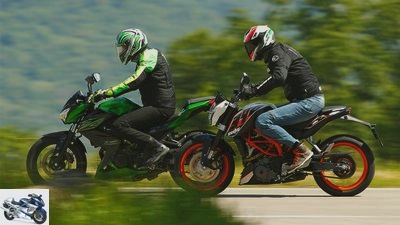
Bilski
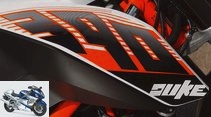
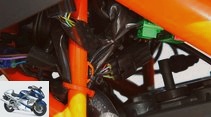
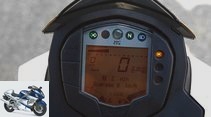
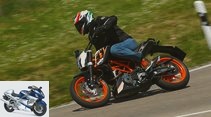
25th photos
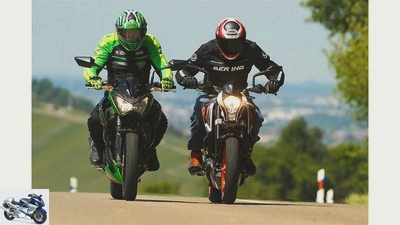
Bilski
1/25
Around 5000 euros are due for the Kawasaki Z 300 and KTM 390 Duke.
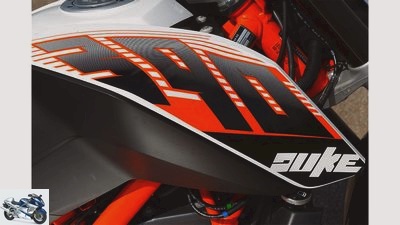
Bilski
2/25
While the number on the right-hand side of the fairing is easy to read, the 390 on the left-hand side of the fairing looks almost like a 340 in the opinion of the slideshow creator. As always, the truth lies somewhere in between: it really has 373 cc.

Bilski
3/25
Unprotected clutter of connectors on the left behind the radiator on the KTM. The author wonders whether they will work in the long term?
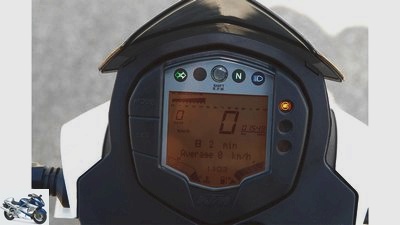
Bilski
4/25
The Duke dashboard gathers a lot of information. But you need a magnifying glass to read the speed.
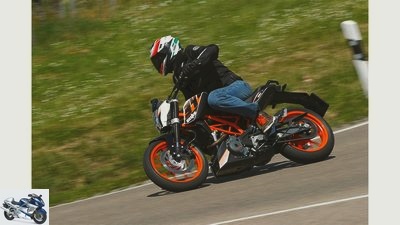
Bilski
5/25
Overall, the processing of the Duke is not quite as fine as that of the Kawasaki. Among other things, the hardware store swing arm leaves room for improvement.
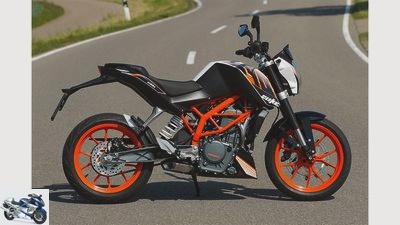
Bilski
6/25
Conclusion: The little Duke is a bestseller in the KTM range for a reason. It offers a lot of motorcycle for the money. The workmanship and chassis could be better – but more expensive bikes can afford such faux pas.
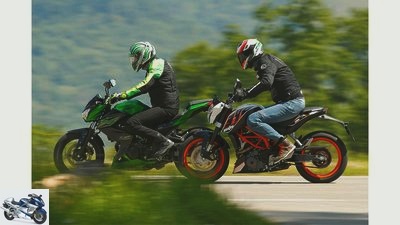
Bilski
7/25
Kawasaki Z 300 and KTM 390 Duke.
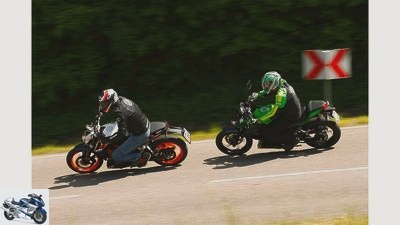
Bilski
8/25
Kawasaki Z 300 and KTM 390 Duke.
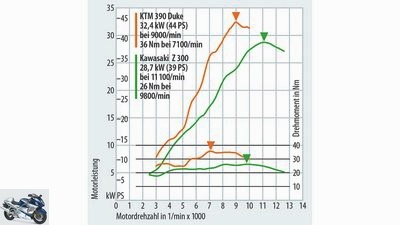
Bilski
9/25
To put it mildly: up to 5000 rpm, the Z 300 and the 390 Duke are separated by only a few horsepower. After that, the performance curves diverge. The gap becomes more than ten hp at a good 7000 revolutions. The already mentioned 77 cm³ difference in displacement are definitely noticeable.
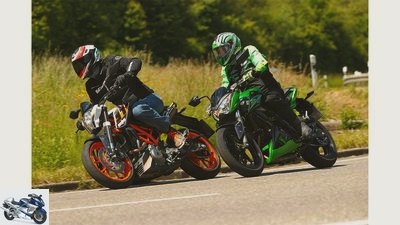
Bilski
10/25
The Kawasaki revs relatively uniformly – only at 7500 and 9500 tours there are slight swings upwards. In contrast, the KTM increases power and torque significantly from the 5000 mark. This is always noticeable in a direct comparison.
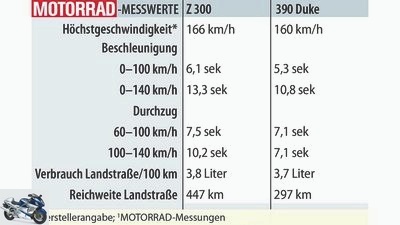
Bilski
11/25
The Z 300 is ahead in terms of top speed and range, but otherwise the Duke decides the measurements for itself.
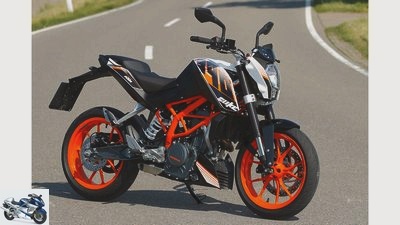
Bilski
12/25
In terms of design, the Duke is also based on its sisters. However, the 390 is immortalized almost unmistakably on the middle Duke. Two smaller (125 Duke and 200 Duke) and one big sister (690 Duke) as well as – let’s call them that – half-sister (1290 Super Duke) complete the family.
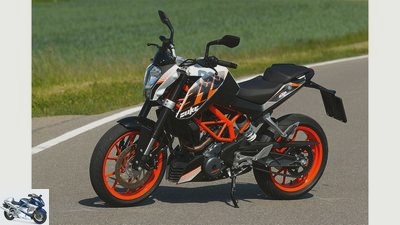
Bilski
13/25
In contrast to the Z 300, it comes from the factory with decent tires: Metzeler M5s rotate on their rims – they grip well and give you a lot of confidence.
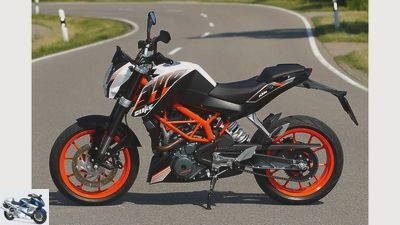
Bilski
14/25
The angularly designed 390 Duke has one less cylinder, but has exactly 77 cm³ more displacement.
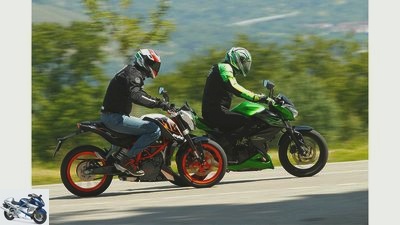
Bilski
15/25
What can you expect from it? A lot, actually.
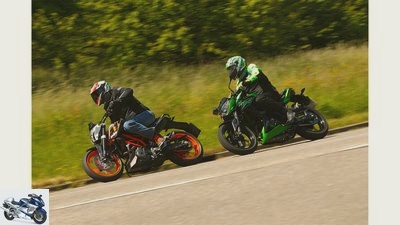
Bilski
16/25
Let’s take a closer look at the two opponents.
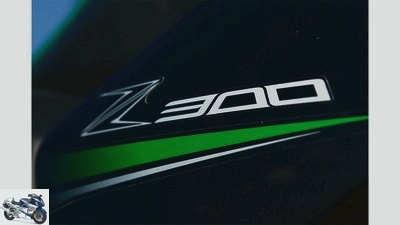
Bilski
17/25
The model name Z 300 would come at the bottom of the alphabet, but the manufacturer Kawasaki comes before KTM alphabetically. That’s why we start with the kawa.
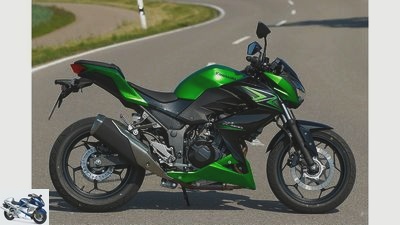
Bilski
18/25
The Z 300 in Manga design is reminiscent of its big sisters Z 800 and Z 1000.
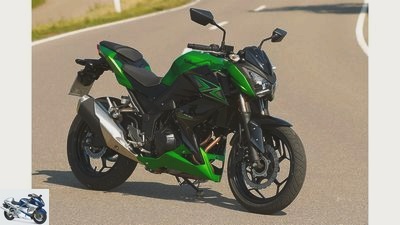
Bilski
19/25
It stands for pure speed, and can definitely score with its fork and shock absorber.
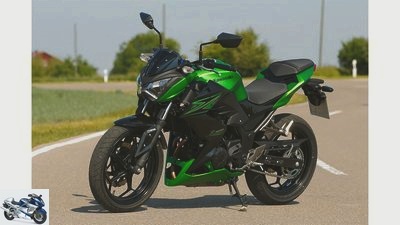
Bilski
20/25
Unfortunately, one notices the saving dictates with the first tires: The IRC Roadwinners look very cheeky, but when they give feedback, they show the pilot the long nose.
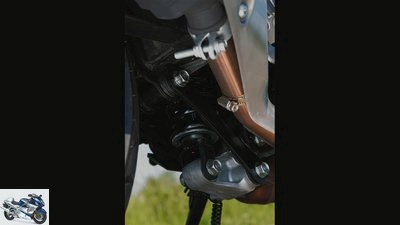
Bilski
21/25
The Z 300 has a shock absorber with deflection, but not the Duke.
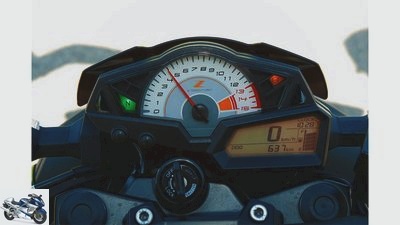
Bilski
22/25
Half-round and easy to read: the rev counter of the Z 300 is ideally in view.
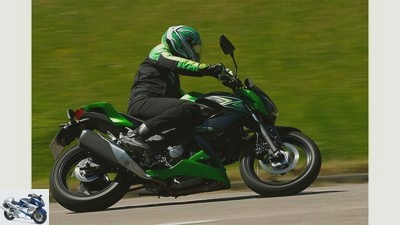
Bilski
23/25
Conclusion: The Z 300 is a speed-hungry mobile game, …
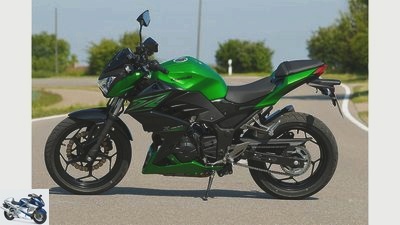
Bilski
24/25
Feather-light handling, balanced chassis – joy is guaranteed. That could even be increased with other tires.
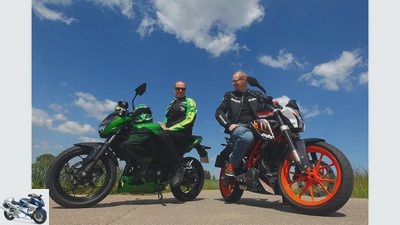
Bilski
25/25
In the end, the only question left is: which one can it be?
Not really matter. The important thing is: for both of them, motorcycle newcomers would not only have pumped their grandmother on 20 years ago, but sold them straight away.
Kawasaki Z 300 and KTM 390 Duke in comparison
For youngsters and beginners
The KTM 390 Duke drives great, looks exactly the same and sells well. How does the Kawasaki Z 300 hold up against it?
Exactly 5853 newly registered motorcycles – this number is on KTM’s credit account for the first four months of this year. The KTM 390 Duke has blossomed into a top seller within the brand. 1049 new owners already had access in 2015. At Kawasaki it looked like a wall. After the Ninja 250 R practically revived the segment from 2008, there have only been 340 new fans for the bikes from Akashi with 250 to 499 cm³ displacement in 2015. That’s supposed to be with the Kawasaki Z 300 become different.
Buy complete article
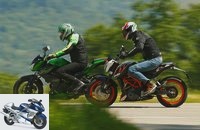
Kawasaki Z 300 and KTM 390 Duke in comparison
For youngsters and beginners
Kawasaki Z 300 with a real 296 cm³ displacement even withstands a critical look down to the last detail. 5,195 euros and therefore not processed quite so nicely? Not with Kawasaki. Only when it comes to tires is the savings dictate. The IRC Roadwinners look very bold, but when they give feedback, they show the pilot the long nose.
Both are not without blame
KTM doesn’t make that mistake with the 390 Duke, which can be had for 4,995 euros. With her, Metzeler’s M5 rotates on the rims. It grips well and gives a lot of confidence. But the workmanship of the Duke is not that fine. Exposed plugs on the left behind the water cooler and a swing axle from the hardware store allow room for improvement. Is it because of the production by Bajaj in India? So both are not without blame. Enough looked – up and away!
Kawasaki Z 300 wants speeds
The knee joint on the KTM 390 Duke is a wasp waistline. Lots of space for the legs. In addition: The pegs are sportily far back and not too high. The knee angle remains relaxed. That doesn’t apply to the butt. The hard seat cushion at a height of 790 millimeters only knows the term comfort from hearsay. The Kawasaki Z 300 cannot do that any better. On the other hand, getting on is even easier than on the 390 Duke. The driver’s seat is only 780 millimeters high. Since the tank is wider and the pegs are similar but positioned further forward, the arrangement for the pilot is more concentrated than on the KTM.
A quick push on the starter and the Kawasaki is there. The two-cylinder immediately runs smoothly with a whisper. The KTM 390 Duke sometimes needs one more ignition before its individual piston starts to work. The 373 cm³ single cylinder scores with higher starting torque and a smooth, precisely controllable clutch. With the Z 300, it doesn’t separate so finely. Your grinding point is also tight. Therefore, it is better to fully accelerate when starting off so that you can move forward. It stays that way. The Kawasaki wants speeds. At least 7000 revolutions are required on the country road. From 9500 rpm there is a little power boost. Only just before 13,000 revolutions does the limiter gently end the drive. The choice of gear is at least as important as the correct speed. Shortly inattentive before the curve and not downshifted? This penalizes the Kawasaki Z 300 when accelerating out from the apex of the curve with very slowed propulsion. So it’s better to step down one gear too much than too little in the precisely engaging gearbox. Then the speed is also right.
Ignore the shift light on the KTM 390 Duke
The KTM 390 Duke drifts through the country much more calmly – at least in terms of revs. It always does it with 3000 rpm less than the Kawasaki Z 300. And since its torque from 5000 rpm even piles up a small hill, it is also more forgiving than the Kawasaki for carelessness when choosing a gear. Nevertheless: If you want to be quick, you have to squeeze the KTM properly. The shift light flickers in gears one to five between 7500 and 8000 rpm. Simply ignore. It is better to let the gas stand just before the limiter and then push in the next gear. The usable speed range also fits. In sixth gear, the gearshift light in the cockpit only asks for attention shortly before the end of engine speed at 10,000 rpm. Otherwise the rider in a hurry would break off any attempt to reach the top speed of 160 km / h much too early.
The Kawasaki Z 300 runs that fast, it even packs six km / h on top. Like the KTM 390 Duke, it doesn’t run like a rocket, but is easy to control. The Kawasaki also causes little headache when it comes to speeding up country roads. The fork cannot be adjusted at all and the shock absorber – albeit difficult to reach – can be adjusted in the suspension base, but the front and rear do their job well. Iron smooth what can be ironed smooth. To do this, the Z 300 playfully turns the corner. Just look, almost not steer, and the Kawa is inclined. Really greedy – or almost nervous? The MOTORRAD testers did not agree. They had fun anyway.
Kawasaki Z 300 more manageable than KTM 390 Duke
That was also the case with the KTM. It needs a nuance more power for the steering impulse, is not quite as handy as the Z 300. But it is fuller, more stable. Until the first bumps in the road get in the way. They keep the fork on the go. Nasty glitches quickly spread across the steering. The front of the KTM 390 Duke never really follows the road surface really smoothly. Since there are no adjustment options, that means: get used to it. The shock absorber acts a little better. Adjusting the spring base is easier than with the Kawasaki, but KTM has saved the deflection. A progressive spring should fix it. However, the KTM shock absorber does not achieve the good mix of comfort and responsiveness of the Kawasaki Z 300. Advantage Kawasaki.
Both of them really blossom in the thicket of curves despite one or the other weakness. The smaller the streets get, the better. Then your performance is not that important. Instead, the nimble nature of the Kawasaki Z 300 and KTM 390 Duke comes to the fore. That puts a smile on your face. The grin persists even when looking at the costs. Both consume less than four liters of petrol in run mode. With a lot of full throttle it’s a liter more.
No brilliant performance when braking
The brakes on the 390 Duke and Z 300 remain far from really crisp, brilliant performances. Their ABS systems effectively prevent falling over the front wheel or rolling over. But they regulate a little rough and are not too snappy. Or to put it positively: fully suitable for beginners. Nothing is frightening. However: to get into the ABS area, you have to pull hard. With the whole hand and not with two fingers. After several emergency stops, the pressure point shifts noticeably. The non-adjustable levers can be pulled more and more towards the handlebars. Nevertheless, both come to a standstill at any time.
In the end, the only question left is: which one should it be? The angularly styled KTM, which offers more engine punch, but has to give up on the chassis? Or the Z 300 in Manga design, which stands for pure speed, with fork and shock absorber in front of the
390 Duke lies, but almost lost this advantage with the first tires? Not really matter. The important thing is: for both of them, motorcycle newcomers would not only have pumped their grandmother on 20 years ago, but sold them straight away. Certainly. Good prospects for the offspring.
Test result
Bilski
Which one should it be now? Kawasaki Z 300 or KTM 390 Duke? You can’t really go wrong with either.
Bilski
Kawasaki Z 300
Kawasaki Z 300
The Kawasaki Z 300 is a speed-hungry playmobile. Feather-light handling, balanced chassis – joy is guaranteed. That could even be increased with other tires.
Bilski
KTM 390 Duke
KTM 390 Duke
The small KTM 390 Duke is a bestseller in the KTM range for a reason. It offers a lot of motorcycle for the money. The workmanship and chassis could be better – but more expensive bikes can afford such faux pas.
Technical specifications
Bilski
Two versus one cylinder, 296 versus 374 cm³.
Related articles
-
Comparison test between Kawasaki GPX 600 R and Suzuki GSX 600 F
Comparison test between the Kawasaki GPX 600 R and the Suzuki GSX 600 F Signs of aging What they are missing in terms of youthful elasticity after more than ten years of service …
-
BMW R 1200 RS and Kawasaki Z 1000 SX in a comparison test
r-photography.info 18th photos r-photography.info 1/18 BMW R 1200 RS and Kawasaki Z 1000 SX. r-photography.info 2/18 BMW R 1200 RS and Kawasaki Z 1000…
-
Comparison test Kawasaki KLR 650-Yamaha XT 600 E.
fact comparison test Kawasaki KLR 650 / Yamaha XT 600 E Simple and poignant The XT 600 E brings back wistful memories of the great …
-
Ducati 1299 Panigale S and Kawasaki Ninja H2 in comparison test
31 pictures 1/31 Left in the picture 197 HP and 145 Nm (Ducati 1299 Panigale S), on the right there are 200 HP and 133 Nm (Kawasaki Ninja H2) ….
-
Triumph Speed Triple and KTM Super Duke in comparison
fact 17th photos fact 1/17 Both bikes are full of power and emotions and can really sweep the rider away, but which one can impress more, the KMT 990…
-
Comparison test KTM Duke II against KTM Supermoto
Comparison between KTM Duke II and KTM Supermoto Caramba, Caracho … … no whiskey, but high-percentage controversy at KTM. Bounces with force …
-
BMW S 1000 XR, Kawasaki ZZR 1400 and KTM 1290 Super Duke GT in the test
Andreas Riedmann 25th photos andreasriedmann.at 1/25 Picture gallery comparison test, power-speed touring bikes: BMW S 1000 XR, Kawasaki ZZR 1400, KTM…
-
KTM 690 Duke R comparison old against new
fact 14 pictures fact 1/14 You just can’t help it: two brisk singles always ask to dance. fact 2/14 2016: 690 Duke R 693 cm³, 75 PS, 74 …
-
Comparison test: MV Agusta Brutale, Triumph Street Triple, KTM Super Duke
fact comparison test: MV Agusta Brutale, Triumph Street Triple, KTM Super Duke Three naked bikes in direct comparison There are motorcycles for which …
-
Comparison test: Honda Varadero 125, Kawasaki KMX 125, MZ 125 SX, Yamaha TDR 125
Comparison test: Honda Varadero 125, Kawasaki KMX 125, MZ 125 SX, Yamaha TDR 125 The upper floors Power from the basement is not with 125 cm3 displacement …